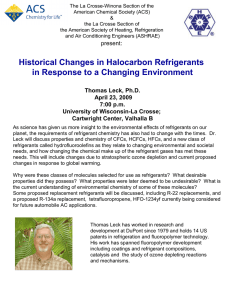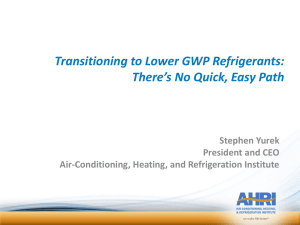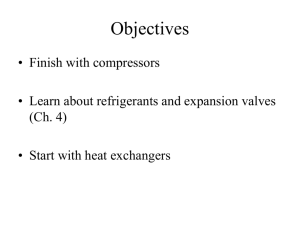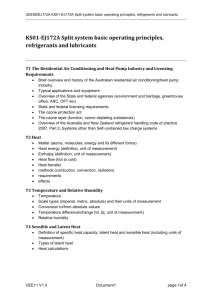Understanding Applications for Alternate Refrigerants
advertisement
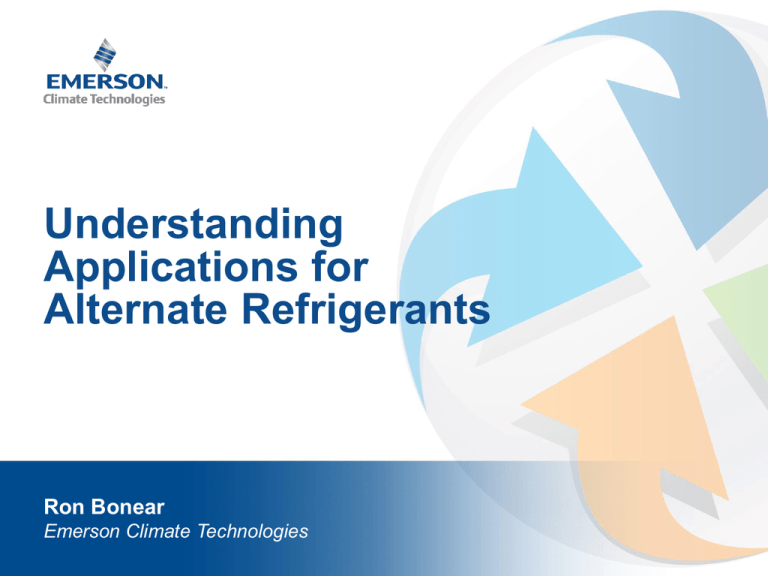
Understanding Applications for Alternate Refrigerants Ron Bonear Emerson Climate Technologies Agenda Overview of R-448A/R-449A Refrigerant Development Methodology – Evaluation Strategy — R-448A /R-449A Refrigerants Performance Development – Thermophysical Comparison of Refrigerants – Refrigerant Performance Reliability Evaluation – Effect of New Refrigerants on Compressor Components – Reliability Assessment R-448A/R-449A Development Summary and Conclusions Brief Update on Alternate Refrigerants — R-450A/R-513A and R-452A Update on ECT’s Alternate Refrigerant Facilities Development Plan R-448A/R-449A Refrigerant Evaluation Methodology Alternate Refrigerant Evaluation — Performance – Focus on Developing Fast/Flexible Refrigerant Release Sidney Refrigeration Engineering Team Developed Test Strategy for Simultaneous Approval of R-448A and R-449A – Equivalent Chemical Composition Between the Two Refrigerants Thermophysical Comparison, Miscibility and Compatibility Analysis Performed on R-448A/R-449A UL Qualification Strategy Objective: Reduce UL Qualification Time – Due to Chemical Equivalency of Refrigerants, UL Agreed to Full Model Line Approvals of Both R-448A/R-449A by Testing Only R-448A – Testing Required to Show That R-448A MCC Amp Values Were ≤ +10% Above R-404A – In All Instances, R-448A Met This Criteria The Majority of MCC Values Fall Below That of R-404A – As a Result, R-448A Has Been Released Using Existing R-404A MCC Values By Utilizing This Approach, It Was Possible to Significantly Reduce the Total Number of Compressors Tested: 8 Scroll Compressors 6 Semi-Hermetic Compressors (4 Discus / 2 KEL) R-448A/R-449A Refrigerant Evaluation Methodology Alternate Refrigerant Evaluation — Reliability – Evaluation of the Interaction of Refrigerants With Oil Miscibility/Solubility/Viscosity – Bearing Analysis Performed Using Mobility Analysis – Full Operating Envelope and Reliability (CFM) Testing Performed Using R-448A/R-449A Agenda Overview of R-448A/R-449A Refrigerant Development Methodology – Evaluation Strategy — R-448A /R-449A Refrigerants Performance Development – Thermophysical Comparison of Refrigerants – Refrigerant Performance Reliability Evaluation – Effect of New Refrigerants on Compressor Components – Reliability Assessment R-448A/R-449A Development Summary and Conclusions Brief Update on Alternate Refrigerants — R-450A/R-513A and R-452A Update on ECT’s Alternate Refrigerant Facilities Development Plan Evaluation of Alternate Refrigerant Performance Evaluation of R-448A/R-449A Relative to Existing Medium- Pressure Refrigerants – Evaluate Equivalency of R-448A Relative to R-449A Evaluate Refrigerant Chemical Compositions – Evaluate R-448A Relative to R-404A and R-407A Thermophysical Comparison of Refrigerants – Pressure Differential – Density – Enthalpy Refrigerant Performance Testing Comparison Evaluation of Refrigerant Chemical Composition R-448A/R-449A Relative Comparison – Both R-448A and R-449A are medium-pressure, A1 refrigerants Verify chemical composition ± 5% Honeywell R-448A Composition DuPont R-449A Composition R-32 (26%) R-32 (24%) R-125 (26%) R-125 (25%) R-134a (21%) R-134a (26%) 1234yf (20%) 1234ze (7%) 1234yf (25%) Determination Made That the Two Refrigerants Are Effectively Chemically Equivalent Evaluation of Refrigerant Pressure Differential Evaluate R-448A ∆P to R-404A/R-407A R-448A exhibits a lower pressure differential than R-404A. R-448A compressor loads will be lower. R-448a and R-407A have essentially identical pressure differentials. Evaluation of Refrigerant Density Evaluate R-448A Density Relative to R-404A/R-407A Evaluation of Refrigerant Enthalpy Evaluate R-448A Theoretical Enthalpy Relative to R-404A/R-407A Scroll MT — Mid/Dew Point Capacity R-404A Versus R-407A/R-448A (20/70) Scroll MT — Mid/Dew Point Capacity R-404A Versus R-407A/R-448A (20/120) Scroll LT — Mid/Dew Point Capacity R-404A Versus R-407A/R-448A (-25/70) Scroll LT — Mid/Dew Point Capacity R-404A Versus R-407A/R-448A (-25/105) Scroll MT — Mid/Dew Point Weighted EER R-404A Versus R-407A/R-448A Scroll LT – Mid / Dew Point Weighted EER R-404A Versus R-407A / R-448A R-448A/R-449A Operating Envelopes — Summary and Conclusions Following Operating Envelope Testing and CFM, R-448A/R-449A Will Use Same Envelope as R-407A R-448A/R-449A Demonstrated Thermophysical Equivalence Discharge Line Temperatures Are Similar to But Slightly Higher Than R-407A at HCR/MDP Conditions – Reliability Testing Confirms Higher Temperatures at Envelope Corners Are Acceptable » Only Map Affected Is ZBK5 Envelope All R-448A/R-449A Are the Same Envelopes as R-407A Only Exception Is ZBK5 Envelope, With Slightly Reduced HCR Corner Point Final R-448A/R-449A MT K5 Operating Envelope Agenda Overview of R-448A/R-449A Refrigerant Development Methodology – Evaluation Strategy — R-448A /R-449A Refrigerants Performance Development – Thermophysical Comparison of Refrigerants – Refrigerant Performance Reliability Evaluation – Effect of New Refrigerants on Compressor Components – Reliability Assessment R-448A/R-449A Development Summary and Conclusions Brief Update on Alternate Refrigerants — R-450A/R-513A and R-452A Update on ECT’s Alternate Refrigerant Facilities Development Plan Refrigerant Reliability Evaluation Refrigerant Reliability Assessment – Reliability Bearing Analysis – Miscibility – Solubility/Viscosity – Mobility Analysis DFMEA – High RPN Failure Modes Drive CFM Test Strategy CFM Testing Summary Refrigerant Reliability Evaluation Reliability Development Envelope Miscibility Evaluation Viscosity Evaluation Mobility Analysis of R-448A Relative to R-404A R-448A/R-449A CFM Summary Evaluated Full Range of Compressors Using Standard Reliability Engineering Procedure Performed CFM Testing at Envelope Corner Points – HCR – MDP – High Load Flooded Start and Defrost Cycles Tested to Verify Miscibility – Ensure Full Hydrodynamic Bearing Film Thickness Following Refrigerant Washout Mobility Used to Validate Minimum Oil Film Thickness to Surface Finish Ratio (ʎ) – R-448A/R-449A Meets or Exceeds ʎ for R-404A All Scroll/Semi-Hermetic Compressors Passed Full Battery of CFM Testing Agenda Overview of R-448A/R-449A Refrigerant Development Methodology – Evaluation Strategy — R-448A /R-449A Refrigerants Performance Development – Thermophysical Comparison of Refrigerants – Refrigerant Performance Reliability Evaluation – Effect of New Refrigerants on Compressor Components – Reliability Assessment R-448A/R-449A Development Summary and Conclusions Brief Update on Alternate Refrigerants — R-450A/R-513A and R-452A Update on ECT’s Alternate Refrigerant Facilities Development Plan R-448A/R-449A Summary and Conclusions From R-448A/R-449A Qualification, the Sidney Refrigeration Engineering Team Has Utilized a Standardized Test Strategy for New Refrigerants - Comparative Evaluation of Refrigerant Properties - Full UL, Performance, Operating Maps and Reliability Testing Thermophysical Similarity of R-448A and R-449A Has Been Verified The Thermophysical Properties of R-448A Are Much Closer to R-407A Than R-404A - R-404A Is Much Denser Than R-448A; Higher Mass Flows - R-448A Exhibits Lower ∆P; Lower Bearing Loading Than R-404A - R-404A Capacity Significantly Greater Than R-448A at LT Conditions, Roughly Equivalent on MT Applications R-448A/R-449A Summary and Conclusions R-448A/R-449A Operating Envelopes Are Equivalent to Current R-407A - Ref ZB*K5 HCR Condensing Will Be Slightly Reduced to Accommodate R-448A/R-449A and R407A on One Map Bearing Analysis Performed by Evaluating Miscibility/Viscosity, Loads, M Mobility Analysis and CFM Comprehensive R-448A/R-449A Performance and Reliability Evaluation Complete Captured Lessons Learned in Standardized Document - Utilized for All New Refrigerant Releases Accuracy and Completeness of Data for Both Performance and Reliability Are Assured Agenda Overview of R-448A/R-449A Refrigerant Development Methodology – Evaluation Strategy — R-448A /R-449A Refrigerants Performance Development – Thermophysical Comparison of Refrigerants – Refrigerant Performance Reliability Evaluation – Effect of New Refrigerants on Compressor Components – Reliability Assessment R-448A/R-449A Development Summary and Conclusions Brief Update on Alternate Refrigerants — R-450A/R-513A and R-452A Update on ECT’s Alternate Refrigerant Facilities Development Plan Update on R-513A/R-450A and R-452A Performance and Initial Reliability Evaluations Underway for Low- Pressure R-513A/R-450A (Europe and U.S.) and for Medium-Pressure R-452A (U.S., Transport Scroll Only) – Preliminary Performance Evaluation for Refrigerants Complete – Initial Reliability Assessments of Both R-452A and R-513A Indicate Higher Solubility Index May Pose Challenge for Compressor Boundary Lubrication Higher Solubility Reduces Oil Viscosity and May Affect Boundary Lubrication During Liquid Applications – Currently Evaluating Alternate, Higher Viscosity Oil as Countermeasure R-450A/R-513A Refrigerant Performance — Capacity R-450A/R-513A Refrigerant Performance — EER R-452A Refrigerant Performance — Capacity R-452A Refrigerant Performance — EER Agenda Overview of R-448A/R-449A Refrigerant Development Methodology – Evaluation Strategy — R-448A /R-449A Refrigerants Performance Development – Thermophysical Comparison of Refrigerants – Refrigerant Performance Reliability Evaluation – Effect of New Refrigerants on Compressor Components – Reliability Assessment R-448A/R-449A Development Summary and Conclusions Brief Update on Alternate Refrigerants — R-450A/R-513A and R-452A Update on ECT’s Alternate Refrigerant Facilities Development Plan Recap of Alternatives for Refrigeration Applications 1 A1 – Non-Flammable A2L – Mildly Flammable Pressure Building or CO2 Capacity HFO 1234yf HFO 1234ze ARM-42 ~600 Qualitative – Not to Scale 3 2 2015 R-448A = N40 R-449A = DR33 R-449B = ARM-32 N20 < 1,500 R-444B = L20 L40, DR7 NH3 ~300 ARM-20b <150 R-32/HFO Blends HDR110 R290 DR3 ARM-20a R-134a Like R-123 Like (V. Low Pr.) 4 2016 R-446A, R-447A, ARM-71a R-32/HFO 400–675 R32 Blends R-410A Like R-404A and R-407/22 Like A3 – Flammable B2L – Toxic, Mildly Flam. R-32/HFC/HFO Blends HFC/HFO R-450A = N13 Blends R-513A = XP10 R-410A R-22 R-407A R-407C R-407F, R-452A = XP44 AR M-35 R-404A R-507A (3922) R134a DR2, N12, ARC 1 0 500 1,000 1,500 2,000 GWP Level Emerson’s A3 / A2L Facilities Development Plan Emerson’s A3 / A2L Facilities Development Plan Emerson’s A3 / A2L Facilities Development Plan Selecting a TXV for Use With R-448A / R-449A / R-513A Brad Hopson Emerson Climate Technologies Selecting a TXV for Use With R-448A / R-449A / R-513A Brad Hopson Emerson Climate Technologies TXV Selection Review 1. Refrigeration Type 2. Evaporator Temperature/Pressure 3. Evaporator Capacity 4. Condensing Temperature/Pressure 5. Liquid Temperature 6. Distributor Type (if used) Note: The valve is sized to the evaporator and not the compressor. Glide and the p-h Diagram Zeotropic Blends Exhibit Glide Calculating Delta P at Expansion Device: – Bubble Point (Saturated Liquid) for Condensing Pressure – Dew Point (Saturated Vapor) for Evaporating Pressure TXV Pressure Differential This Is Also the Delta P at the Expansion Device Lower Delta P Generally Lowers Valve Capacity In the Given Applications, the Change in Pressure Differential Is Very Small Superheat Superheat Curves (and Other Secrets) Evaporator Temp. R-404A Bulb Charges Are NOT Optimized for R-448/449 Superheat Settings MUST Be Adjusted At Low Temps, the Superheat Tends to Rise Low-Temp. Valve Capacity Adjustment Low-Temp. Applications Require Larger Valves In Practice, Choose a Valve With 50% More Capacity Summary Pressure Differential: – Use Bubble Point for Condensing Pressure – Use Dew Point for Evaporating Pressure R-513A — Use R-134A Tables R-448A/R-449A – Medium-Temp – Very Similar to R-404A – Low-Temp – Select Approximately 50% More Capacity Thank You! Questions? DISCLAIMER Although all statements and information contained herein are believed to be accurate and reliable, they are presented without guarantee or warranty of any kind, expressed or implied. Information provided herein does not relieve the user from the responsibility of carrying out its own tests and experiments, and the user assumes all risks and liability for use of the information and results obtained. Statements or suggestions concerning the use of materials and processes are made without representation or warranty that any such use is free of patent infringement and are not recommendations to infringe on any patents. The user should not assume that all toxicity data and safety measures are indicated herein or that other measures may not be required.

